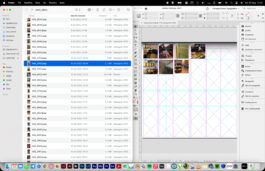Macintosh HD/Users/LERO/Desktop/Post_diary
21,791,728,925 bytes (21.85 GB on internal disk)
The project, titled “Post Diary”, unfolds as a visual narrative that redefines the boundaries of traditional archiving, shifting its focus from the mere cataloging of physical objects to the preservation of an emotional and intangible space. It transcends the conventional understanding of place as a fixed, geographical location, presenting instead a deeply intimate and personal experience. This act of archiving becomes a way of navigating between fullness and emptiness—two seemingly opposing states that, in their interplay, mirror the complexity of human memory and emotion.
At its core, the project transforms a digital accumulation of data—21.85 GB stored on an internal disk—into something much more profound: a witness to life. This repository of files, moments, and interactions embodies not only a documentation of events but also a reflection of the lived experience in Urbino. Here, the city is not merely a backdrop; it emerges as an active participant in the narrative, shaping and being shaped by the memories it holds. Urbino becomes a foundation, a canvas upon which the project explores the nuanced interplay between space, memory, and emotion.
Archiving, within this context, becomes an act of care and preservation, one that transcends the mechanical process of storing data. It becomes a way to safeguard images, people, and fleeting moments, giving them a sense of permanence against the inevitable flow of time. This process reflects a profound tenderness—an acknowledgment of the impermanence of life and a desire to hold onto what might otherwise be lost. It is as much about preserving the past as it is about creating a framework for understanding the self and one’s relationship with the world.
However, the project does not limit itself to documenting what has already occurred. It ventures into the realm of the imagined and the unspoken, giving voice to silences, pauses, and absences that often go unnoticed. These gaps, moments of suspension between the lived and the unrealized, carry a weight of their own. They represent the potentialities, the dreams, and the fragments of a relationship with Urbino that remain undefined or incomplete.
Through this interplay of presence and absence, the project not only outlines the physical and emotional connections to the city but also delves into the inner workings of memory. It explores how we remember—not just in terms of what we recall but also in what we forget or leave behind. These absences, these spaces of quiet, become as significant as the images themselves, adding layers of depth and ambiguity to the narrative.
Ultimately, “Post Diary” is a meditation on the act of archiving as a deeply human endeavor. It challenges the notion of archives as static repositories and instead presents them as dynamic spaces where life continues to unfold. By blending the digital and the emotional, the lived and the imagined, the project invites viewers to reflect on their own relationships with place, memory, and the ephemeral nature of existence. It transforms the ordinary—bytes of data on a hard drive—into a poetic exploration of life’s fragility and beauty.
Urbino, 2022-2024
Photography and design
Lorenzo Urgesi
Supervisor
Giovanna Silva
Giacomo Bianco
































Macintosh HD/Users/LERO/Desktop/Post_diary
21,791,728,925 bytes (21.85 GB on internal disk)
The project, titled “Post Diary”, unfolds as a visual narrative that redefines the boundaries of traditional archiving, shifting its focus from the mere cataloging of physical objects to the preservation of an emotional and intangible space. It transcends the conventional understanding of place as a fixed, geographical location, presenting instead a deeply intimate and personal experience. This act of archiving becomes a way of navigating between fullness and emptiness—two seemingly opposing states that, in their interplay, mirror the complexity of human memory and emotion.
At its core, the project transforms a digital accumulation of data—21.85 GB stored on an internal disk—into something much more profound: a witness to life. This repository of files, moments, and interactions embodies not only a documentation of events but also a reflection of the lived experience in Urbino. Here, the city is not merely a backdrop; it emerges as an active participant in the narrative, shaping and being shaped by the memories it holds. Urbino becomes a foundation, a canvas upon which the project explores the nuanced interplay between space, memory, and emotion.
Archiving, within this context, becomes an act of care and preservation, one that transcends the mechanical process of storing data. It becomes a way to safeguard images, people, and fleeting moments, giving them a sense of permanence against the inevitable flow of time. This process reflects a profound tenderness—an acknowledgment of the impermanence of life and a desire to hold onto what might otherwise be lost. It is as much about preserving the past as it is about creating a framework for understanding the self and one’s relationship with the world.
However, the project does not limit itself to documenting what has already occurred. It ventures into the realm of the imagined and the unspoken, giving voice to silences, pauses, and absences that often go unnoticed. These gaps, moments of suspension between the lived and the unrealized, carry a weight of their own. They represent the potentialities, the dreams, and the fragments of a relationship with Urbino that remain undefined or incomplete.
Through this interplay of presence and absence, the project not only outlines the physical and emotional connections to the city but also delves into the inner workings of memory. It explores how we remember—not just in terms of what we recall but also in what we forget or leave behind. These absences, these spaces of quiet, become as significant as the images themselves, adding layers of depth and ambiguity to the narrative.
Ultimately, “Post Diary” is a meditation on the act of archiving as a deeply human endeavor. It challenges the notion of archives as static repositories and instead presents them as dynamic spaces where life continues to unfold. By blending the digital and the emotional, the lived and the imagined, the project invites viewers to reflect on their own relationships with place, memory, and the ephemeral nature of existence. It transforms the ordinary—bytes of data on a hard drive—into a poetic exploration of life’s fragility and beauty.
Urbino, 2022-2024
Photography and design
Lorenzo Urgesi
Supervisor
Giovanna Silva
Giacomo Bianco































